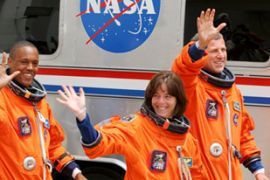Smooth lift-off for Endeavour
But critics say Nasa wasting money for PR that yields little scientific progress.

| Waste of money? | ||
|
Critics accuse Nasa of wasting trillions of US taxpayer dollars sending men and women into space for what amounts to great public relations but little in the way of visible scientific progress.
Robert Park, a physicist, says: “Every advance we have made in space has been made with robots… so far the human space program has held us back, it’s not advanced us at in space.”
Manned space travel is much more expensive than unmanned exploration, and arguably stands in the way of advancing space science with robotics.
The Endeavour spacecraft cost $2.2bn to construct. It will never leave lower orbit, confined mostly to maintaining the outdated International space station.
By comparison, the unmanned Phoenix vessel currently on a 10-month journey to the north pole of Mars, cost just over $400m and may yet reveal the secrets of the red planet.
Park asks: “What is it that we are sending the humans to find? What is it that we’re sending them to do that we can’t design a machine to do better?”
“If it’s just for the thrill, send them bungee jumping. This is not a thrill the taxpayers ought to be paying for.”
But sending people to the stars is seen as central to the frontier spirit that America still embraces and Nasa depends on the enchantment of the public to support its $17bn a year budget.
Roger Launius, Nasa’s former chief historian says “this is where science meets psychology”.
“The American space programme is, to many Americans, a critical chapter of US history which began with first settlers on ships then pioneers in wagons.”
Endeavour is due to be replaced in 2010 by a new manned spacecraft called Orion.
Its mission is to return to the moon by the year 2020, at a fraction of the cost of previous lunar missions. |
Endeavour’s lift-off had been scheduled for Tuesday but Nasa delayed it due to a leaky valve in the crew cabin which needed replacement.
